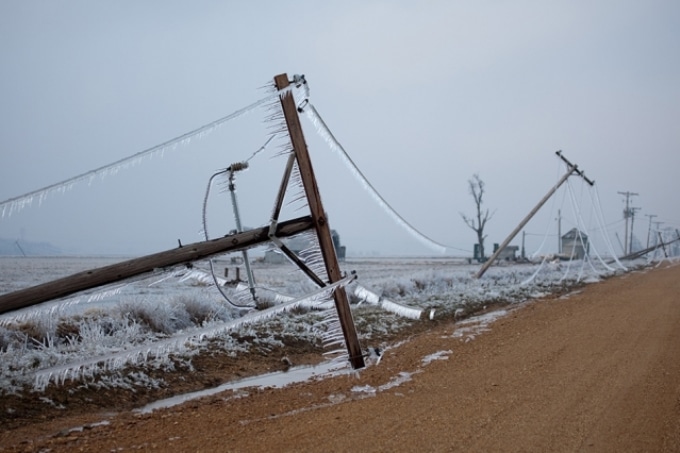Sep 6 2018
From overhead powerlines to airplane wings to the massive blades of wind turbines, a buildup of ice can cause problems ranging from reduced performance all the way to disastrous failure. But preventing that buildup typically requires chemical sprays or energy-intensive heating systems that are environmentally destructive. Presently, MIT scientists have developed a totally passive, solar-powered way of dealing with ice buildup.
 Image credit: MIT
Image credit: MIT
The system is extraordinarily simple, based on a three-layered material that can be coated or even sprayed onto the surfaces to be treated. It gathers solar radiation, transforms it to heat, and spreads that heat around so that the melting is not just limited to the areas exposed directly to the sun’s rays. Then after it is applied, it requires no additional action or power source. It can even perform its de-icing work at night, with the help of artificial lighting.
The new system has been described recently in the journal Science Advances, in a paper by MIT associate professor of mechanical engineering Kripa Varanasi and postdocs Susmita Dash and Jolet de Ruiter.
Icing is a major problem for aircraft, for wind turbines, power lines, offshore oil platforms, and many other places. The conventional ways of getting around it are de-icing sprays or by heating, but those have issues.
Kripa Varanasi
Inspired by the Sun
The typical de-icing sprays for aircraft and other applications use ethylene glycol, a chemical that is not environmentally friendly. Airlines do not like to use active heating, both for safety reasons and cost. Varanasi and other researchers have explored the use of superhydrophobic surfaces to stop icing passively, but those coatings can be weakened by frost formation, which is likely to fill the microscopic textures that offer the surface its ice-shedding properties.
As a substitute line of inquiry, Varanasi and his team took into consideration the energy emitted by the sun. They wanted to check, he says, whether “there is a way to capture that heat and use it in a passive approach.” They learned that there was.
It is not crucial to create sufficient heat to melt the bulk of the ice that build up, the team found. All that is required is for the boundary layer, exactly where the ice meets the surface, to melt sufficiently to create a thin layer of water, which will make the surface quite slippery so any ice will simply slide right off. This is what the team has accomplished with the three-layered material they have developed.
Layer by Layer
The top layer is an absorber, which captures incoming sunlight and changes it to heat. The material used by the team is very efficient, absorbing 95% of the incident sunlight, and losing just 3% to re-radiation, Varanasi says.
In principle, that layer could in itself help to stop formation of frost, but with two restrictions: It would only function in the areas exposed directly to sunlight, and much of the heat would be lost back into the substrate material - the powerline or airplane wing, for instance - and would not aid with the de-icing.
Therefore, to compensate for the localization, the team incorporated a spreader layer - a very thin layer of aluminum, only 400 µm thick, which is heated by the absorber layer above it and very efficiently spreads that heat out laterally to span the whole surface. The material was selected to possess “thermal response that is fast enough so that the heating takes place faster than the freezing,” Varanasi says.
Lastly, the bottom layer is only foam insulation, to preserve any of that heat from being wasted downward and keep it where it is required, at the surface.
“In addition to passive de-icing, the photothermal trap stays at an elevated temperature, thus preventing ice build-up altogether,” Dash says.
The three layers, all composed of low-cost commercially available material, are then bonded together, and can be bonded to the surface that has to be protected. For certain applications, the materials could instead be sprayed onto a surface, layer by layer, the scientists say.
The team performed wide-ranging tests, including real-world outdoor testing of the materials and detailed laboratory measurements, to confirm the system’s effectiveness.
The use of photothermal absorbers is a smart idea and straightforward to implement. Scalability of these approaches and thinking about appropriate packaging, specific weight, etc., of the de-icing layer are important practical challenges going ahead, especially when it comes to the aerospace application. The paper also opens up intriguing possibilities around smart and flexible thermal packaging, and thermal metamaterials research to realize its full potential. Overall, an excellent step forward.
Manish Tiwari, Professor of Nanoengineering at University College London
The system could find even broader commercial applications, such as panels to stop icing on roofs of schools, homes, and other buildings, Varanasi adds. Going forward, the MIT team plans to continue working on the system, testing it for longevity and for ideal methods of application. But the typical system could fundamentally be applied almost directly for some uses, especially stationary applications, he says.
The study was aided by Alstom and the Netherlands Organization for Scientific Research.